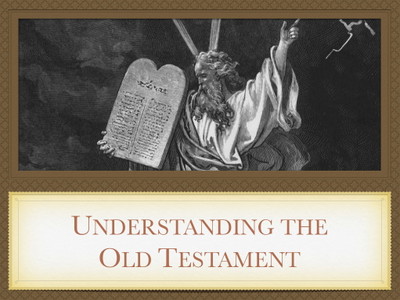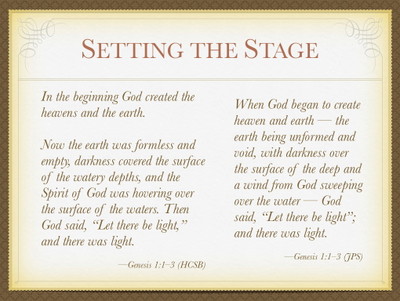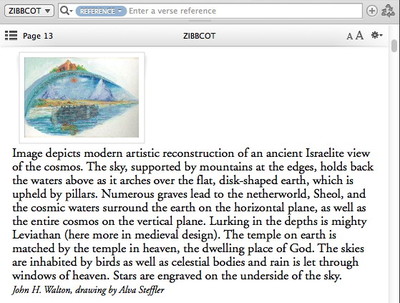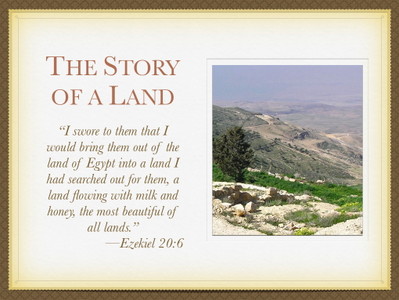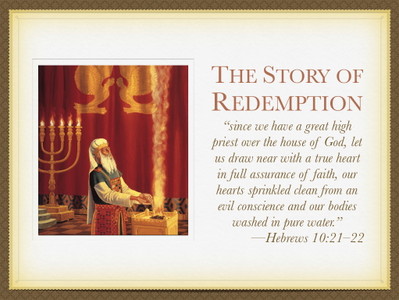In the probably-bit-off-more-than-I-can-chew department, I’ve recently begun teaching a Sunday School class on “Understanding the Old Testament.” My intention in this class is to give folks a birds’ eye view of the Old Testament, exposing them to parts of the Bible they rarely visit and often struggle to understand. To do this effectively, I can’t afford to spend a lot of time going into depth on individual passages. So naturally, I’ve spent the last six weeks or so going through Genesis 1 and 2! At this rate, I may finish when I’m sixty!
My inability to skim the surface aside, I’ve been preparing a Keynote slide show each week to help focus my class’s attention on the main points I want to get across. And since I tend to procrastinate, I’m thankful for great Accordance resources and a few simple tricks that make preparing this slide show a snap!
First, let me talk about some of the resources I’m using.
Bibles: As readers of this blog are probably aware by now, my preferred translation is the Holman Christian Standard Bible (HCSB). It offers a good mix of readability and fidelity to the original languages, and is generally unafraid to offer a fresh translation of those well-known passages most translations are unwilling to modify (John 3:16, Psalm 23, Matthew 5-7, etc.). Of course, when I want to bring out an aspect of the text which is made clearer in another translation, I won’t hesitate to use it. For example, when I want to bring out the structure of the underlying Hebrew text, I’ll generally turn to the English Standard Version (ESV). When I wanted to discuss whether Genesis 1:1 should be translated “In the beginning God created” or “When God began to create”, I used the Jewish Publication Society translation (JPS) as an example of the latter rendering.
Finally, while I don’t show the underlying Hebrew text to my class, I do use the tagged Hebrew text in my own preparation to teach.
Commentaries: While I’m going into the first three chapters of Genesis in some depth, I am not doing a lot of verse-by-verse exposition. Rather, I’m focusing on bringing out the literary structure of these texts and the way they would have been understood by their original audience. Consequently, I don’t often turn to expositional and critical commentaries when preparing for my class. Instead, I tend to go to background commentaries like the Zondervan Illustrated Bible Background Commentary on the Old Testament (ZIBBCOT) and the IVP Bible Background Commentary on the Old Testament. I once read a review by a New Testament scholar I admire who panned the use of background commentaries because any more traditional commentary worth its salt will usually provide the relevant historical background information. While that’s certainly true, the challenge is often finding those nuggets amid all the verse-by-verse exposition. I love these background commentaries because they’re focused on the kind of information I most want to bring out.
For much the same reason, I often find myself turning to Study Bible notes before full-blown commentaries. Study Bibles like the ESV Study Bible often have concise but highly relevant information, as well as helpful charts and images that can easily be incorporated into a Keynote presentation.
Graphic Resources: Some of the commentaries and study Bibles already mentioned are a great source for visuals that can be dragged into Keynote slides. ZIBBCOT had a great illustration of the three-tiered cosmology which most ancient peoples assumed to exist, and it made such concepts as water above the sky much easier to explain.
The ESV Study Bible offered a concise chart of the days of forming and filling in Genesis 1 that helped me think through how to structure that particular slide of my presentation.
Another graphic resource I use heavily is The Accordance Gallery of Bible Art. Filled with great classic artistic depictions of various Biblical episodes, I tend to use the images in this tool to illustrate broad concepts and to add visual punch to title slides. While I’m still a little early in the Old Testament to make much use of the Bible Lands PhotoGuide, I did use the view of Israel from atop Mount Nebo to illustrate my slide that talked about the Old Testament being “The Story of a Land.”
I likewise used an image of the high priest offering incense from Carta’s Illustrated Encyclopedia of the Holy Temple in Jerusalem for the slide on the Old Testament as “The Story of Redemption.”
While I will turn to other Accordance resources from time to time, this combination of Bibles, background commentaries, study Bibles, and visual resources has served me well in quickly putting together my Keynote presentation each week. In my next post, I’ll show you some of the tricks I use to get the information out of Accordance and into Keynote as quickly and painlessly as possible.


